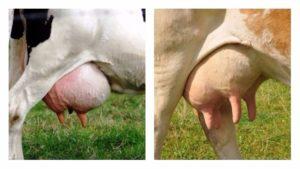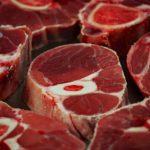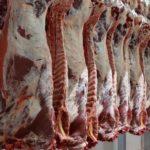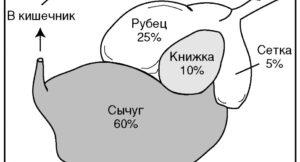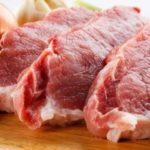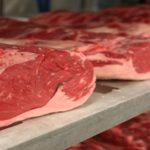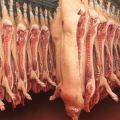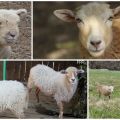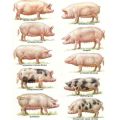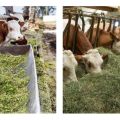Yield Table of Average Net Beef Meat Based on Live Weight
One of the main indicators of the productivity of cows, bulls and other representatives of cattle is the slaughter yield of meat. This term differs from the actual weight at the time of slaughter. It is possible to calculate the yield of beef meat on the basis of pre-slaughter live weight in zootechnical tables, using formulas and calculators. The direction of the breed, age, the chosen scheme of feeding the livestock affects the final indicator.
What is slaughter weight and lethal output
Slaughter weight of cattle - weight of gutted and processed carcasses. The calculations do not take into account the insides, head, hock and wrist joints of the legs, skin, bristles (in pigs). The volume of blood released is also not counted. After cutting and evisceration, the slaughter yield is calculated.
Slaughter yield - the ratio of slaughter weight to actual weight. To calculate the live weight, individuals must be weighed before being sent for slaughter. The data obtained are compared, indicated as a percentage.
Slaughter yield table for cattle
The value is measured as a percentage. Specific numbers depend on the breed lines of cattle: for dairy cows it is 40%, for meat and dairy cows - 70, for meat - more than 80. The beef yield is calculated after gutting. Internal fat, blood, lower legs, brain from the head, and other giblets are not included in the determination. Below are the average statistical indicators for different breeds of cattle, 18 months old at the time of slaughter.
| Breed variety | Red steppe | Simmental | Black and white | Hereford | Charolais | Aberdeen Angus |
| Pre-slaughter weight (average) | 420 | 484 | 444 | 446 | 490 | 429 |
| Slaughter weight | 230 | 264 | 248 | 250 | 288 | 238 |
| Slaughter exit | 60 | 59 | 59 | 61 | 63 | 60 |
| Pulp content% | 81 | 85 | 79 | 80 | 80 | 81 |
| Fat to pulp ratio% | 5 | 4 | 5 | 6 | 5 | 6 |

After evisceration, about half of the actual weight is lost. Internal organs and similar structures are not considered when determining the yield of beef. But they also have their own weight. The table shows the average indicators for cattle slaughtered at the age of 18 months.
| Organ / system | Kilograms |
| A heart | 3 |
| Kidney | 2 |
| Front and back leg | 2-4 |
| Leather (hide) | 15 |
| Scar | 17 |
| Bones | 110-120 |
| Blood | 8% of live weight |
| Intestines | 60-80 |
You can determine the slaughter yield of cattle meat using formulas or a calculator. The easiest way is to use an online calculator on zootechnical sites. Such functions allow you to calculate the mass of cattle even without using weights.
Factors affecting performance
The first is the breed of cattle and its direction. Most of all beef can be obtained from meat breeds: the weight of a heifer - from 600 kg, a bull - from 800 kg. Dairy and meat-and-dairy cows have a mediocre meat yield. The next factor is category. There are 4 of them:
- A - perfect. The actual weight of the animal is over 500 kg.
- B is the first. The numbers range from 400-500.
- C is the second. Up to 450 kg.
- D - third. Up to 300 kg of cattle from this category are subject to rejection.
Other influencing factors include the quality of livestock maintenance, the fullness of the diet, and the state of health. Individuals need different times to gain maximum weight. Representatives of early maturing breeds can be slaughtered as early as 17-18 months. Normal breeds take 2 years on average. The mass of a heifer is always less than that of a bull, the difference reaches 500 kg.

Requirements for cows and heifers
For slaughter, beef cows are sent, which have a well-developed muscle mass, there are no spinous processes of the spine. Their body is rounded, and the shoulder blades are almost invisible. Also, ischial growths, mackerels are not visible. For dairy cows, the norms and requirements are below:
- At slaughter, the presence of protruding blades and bones is allowed.
- Poorly developed musculature.
- Small fat accumulations.
For first-calf heifers (up to 350 kg), other requirements are put forward. This is the presence of a good body fat that can be felt before slaughter. The physique should be round. Shoulder blades, bony tubercles without sharp protrusions.

Determination of the quality of meat products and their composition
The quantity and quality of meat in the carcass of cattle is influenced by fattening phenomena, the quality of zootechnical work. The beef contains tissues of adipose, muscle and connective nature. The presence of a minimum amount of cartilage, blood vessels or lymph nodes is allowed. Clean meat contains the following ingredients:
- Protein - content up to 22%.
- Fat - 2-3%.
- Carbohydrates and other inorganic compounds - from 5%.
The meat is of the highest quality from young castrated bulls. In older animals, an increased content of refractory lipid, this negatively affects the digestibility of the product.
In 2-3 hours after slaughter, the stage of rigor mortis begins: excess moisture comes out of the meat. The sharpness of smell and taste is lost, but tenderness and juiciness appear.
Indicators of quality and freshness - color, smell and consistency of the product. Cows have red fresh meat, calves have whitish pink, pigs have pinkish red. It is dense in consistency, the fossa quickly dissolves after pressing. The presence of foreign odors is not allowed. The color of beef fat is white, yellowish or creamy.
Weight record holders
In the history of livestock practice, there are cases when the weight of cattle significantly exceeded the established standards. The male record holder is a porcelain bull from Switzerland. Its dimensions are 1.9 meters in height and about 1,740 tons of live weight. The record holder among females is a Holstein-Durkhman cow. Her body length is more than 400 cm, the actual weight is 2,200 tons, the sternum girth is 4 m.
Net weight of beef after slaughter is an indicator that determines productivity. For decoding, they use the concepts of slaughter weight and output. This is the weight of the gutted carcass and its percentage of the pre-slaughter weight. The highest quality indicators of productivity in beef cows. The best beef comes from young or castrated bulls.
